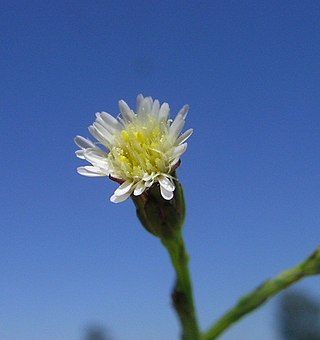
Verbena, also known as vervain or verveine, is a genus in the family Verbenaceae. It contains about 150 species of annual and perennial herbaceous or semi-woody flowering plants. The majority of the species are native to the Americas and Asia; however, Verbena officinalis, the common vervain or common verbena, is the type species and native to Europe.

Symphyotrichum is a genus of over 100 species and naturally occurring hybrids of herbaceous annual and perennial plants in the composite family, Asteraceae, most which were formerly treated within the genus Aster. The majority are endemic to North America, but several also occur in the West Indies, Central and South America, as well as one species in eastern Eurasia. Several species have been introduced to Europe as garden specimens, most notably New England aster and New York aster.

Colubrina is a genus of about 30 species of flowering plants in the family Rhamnaceae, native to warm temperate to tropical regions of Africa, the Americas, southern Asia, northern Australia, and the Indian Ocean islands.

Iresine is a genus of flowering plants in the family Amaranthaceae. It contains 20 to 25 species, all of which are native to the American tropics. The generic name is derived from the Greek word εριος (erios), meaning "wooly", referring to the trichome-covered flowers. Bloodleaf is a common name for those species that have colored foliage, and these are often cultivated as ornamental plants. Some species are additives to versions of the hallucinogenic drink ayahuasca.

Astereae is a tribe of plants in the family Asteraceae that includes annuals, biennials, perennials, subshrubs, shrubs, and trees. They are found primarily in temperate regions of the world. Plants within the tribe are present nearly worldwide divided into over 250 genera and more than 3,100 species, making it the second-largest tribe in the family behind Senecioneae.

Isocoma, commonly called jimmyweed or goldenweed, is a genus of North American semi-woody shrubs in the family Asteraceae. It is found in the semi-arid areas of Southwestern United States and Mexico.

Ericameria nauseosa, commonly known as chamisa, rubber rabbitbrush, and gray rabbitbrush, is a shrub in the sunflower family (Aster) found in the arid regions of western North America.

Pseudognaphalium is a genus of flowering plants in the sunflower family. Members of the genus are commonly known as cudweeds or rabbit tobacco. They are widespread in tropical and temperate regions of many countries.
Guy L. Nesom is an American writer and botanist.
Tomentaurum is a genus of Mexican plants in the family Asteraceae. Its species are native to northern Mexico.
Tomentaurum vandevenderorum is a species of flowering plant in the family Asteraceae, native to the state of Chihuahua in northern Mexico. It was first described by Billie Lee Turner in 1987 as Heterotheca vandevenderorum.

Symphyotrichum subulatum, commonly known as eastern annual saltmarsh aster or, in Britain and Ireland where it is naturalized, annual saltmarsh aster, is an annual plant in the family Asteraceae native to the eastern United States and the Gulf Coast to Texas. The species grows primarily in coastal salt marshes, although in the Ozarks it occurs as a non-marine weedy variety.
Ericameria watsonii, or Watson's goldenbush, is a North American species of flowering shrubs from the family Asteraceae. It is native to the states of Nevada, Utah, and Arizona in the southwestern United States.

Erythranthe, the monkey-flowers and musk-flowers, is a diverse plant genus with more than 120 members in the family Phrymaceae. Erythranthe was originally described as a separate genus, then generally regarded as a section within the genus Mimulus, and recently returned to generic rank. Mimulus sect. Diplacus was segregated from Mimulus as a separate genus at the same time. Mimulus remains as a small genus of eastern North America and the Southern Hemisphere. Molecular data show Erythranthe and Diplacus to be distinct evolutionary lines that are distinct from Mimulus as strictly defined, although this nomenclature is controversial.

Diplacus is a plant genus in the family Phrymaceae, which was traditionally placed in family Scrophulariaceae. In the 2012 restructuring of Mimulus by Barker, et al., based largely upon DNA evidence, seven species were left in Mimulus, 111 placed into Erythranthe, 46 placed into Diplacus, two placed in Uvedalia, and one each placed in Elacholoma, Mimetanthe, and Thyridia. Diplacus used to be a separate genus from Mimulus, but it was merged into Mimulus no later than 1905, until the 2012 restructuring. Dry and rocky areas are preferred.

Symphyotrichum patens, commonly known as late purple aster or spreading aster, is a perennial, herbaceous plant found in the eastern United States.
Vesper is a genus of flowering plants belonging to the family Apiaceae.

Symphyotrichum carnerosanum is a species of flowering plant in the family Asteraceae endemic to the Mexican states of Coahuila, Nuevo León, and Tamaulipas.












